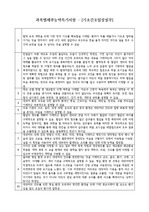Analysis of Rat Mitochondrial Proteome Reveals Effects of Exercise on Tissue Specific Changes of Metabolism
*상*
다운로드
장바구니
소개글
학위 논문입니다.목차
없음본문내용
Exercise affects various physiological phenotypes such as weight loss, anti-aging, and the increasing of heart and skeletal muscle mass. However there is the shortage of researches about proteins which are correlated with such physiological phenotype and their expression. Also, there were many evidences that showed protein expression was different according to tissue and organelle. Among organelles, mitochondria have strongest relation with energy metabolism which is required by exercise. Thus, to understand exercise effects on mitochondria, we identified mitochondrial proteins of heart, brain, muscle, and liver in rat. Using identified 422 mitochondrial proteins, we analyzed expression changes. By constructing new parameter we measured the difference of expression changes among four tissues. We found that the expression of proteins having metabolic function altered tissue-specifically. Especially the decreasing of brain metabolic proteins included in glucose metabolic proteins were significantly decreased. These results show that exercise affects brain more than we expected. This study suggests the way to research exercise response and provide reliable proteomic data about exercise.참고 자료
Boveris, A., and Navarro, A. (2008). Systemic and mitochondrial adaptive responses to moderate exercise in rodents. Free Radic Biol Med 44, 224-229.Chinsomboon, J., Ruas, J., Gupta, R.K., Thom, R., Shoag, J., Rowe, G.C., Sawada, N., Raghuram, S., and Arany, Z. (2009). The transcriptional coactivator PGC-1alpha mediates exercise-induced angiogenesis in skeletal muscle. Proc Natl Acad Sci U S A 106, 21401-21406.
Cox, B., Kislinger, T., and Emili, A. (2005). Integrating gene and protein expression data: pattern analysis and profile mining. Methods 35, 303-314.
Dennis, G., Jr., Sherman, B.T., Hosack, D.A., Yang, J., Gao, W., Lane, H.C., and Lempicki, R.A. (2003). DAVID: Database for Annotation, Visualization, and Integrated Discovery. Genome Biol 4, P3.
Eisen, M.B., Spellman, P.T., Brown, P.O., and Botstein, D. (1999). Cluster analysis and display of genome-wide expression patterns (vol 95, pg 14863, 1998). P Natl Acad Sci USA 96, 10943-10943.
Erales, J., Lignon, S., and Gontero, B. (2009). CP12 from Chlamydomonas reinhardtii, a permanent specific "chaperone-like" protein of glyceraldehyde-3-phosphate dehydrogenase. J Biol Chem 284, 12735-12744.
Evangelista, F.S., Brum, P.C., and Krieger, J.E. (2003). Duration-controlled swimming exercise training induces cardiac hypertrophy in mice. Braz J Med Biol Res 36, 1751-1759.
Fehrenbach, E. (2007). Multifarious microarray-based gene expression patterns in response to exercise. J Appl Physiol 102, 7-8.
Forner, F., Foster, L.J., Campanaro, S., Valle, G., and Mann, M. (2006). Quantitative proteomic comparison of rat mitochondria from muscle, heart, and liver. Mol Cell Proteomics 5, 608-619.
Higdon, R., and Kolker, E. (2007). A predictive model for identifying proteins by a single peptide match. Bioinformatics 23, 277-280.
Huang da, W., Sherman, B.T., and Lempicki, R.A. (2009). Systematic and integrative analysis of large gene lists using DAVID bioinformatics resources. Nat Protoc 4, 44-57.
Johnson, D.T., Harris, R.A., French, S., Blair, P.V., You, J., Bemis, K.G., Wang, M., and Balaban, R.S. (2007). Tissue heterogeneity of the mammalian mitochondrial proteome. Am J Physiol Cell Physiol 292, C689-697.
Kanehisa, M., and Goto, S. (2000). KEGG: kyoto encyclopedia of genes and genomes. Nucleic Acids Res 28, 27-30.
Kanehisa, M., Goto, S., Furumichi, M., Tanabe, M., and Hirakawa, M. (2010). KEGG for representation and analysis of molecular networks involving diseases and drugs. Nucleic Acids Res 38, D355-360.
Kanehisa, M., Goto, S., Hattori, M., Aoki-Kinoshita, K.F., Itoh, M., Kawashima, S., Katayama, T., Araki, M., and Hirakawa, M. (2006). From genomics to chemical genomics: new developments in KEGG. Nucleic Acids Res 34, D354-357.
Kemppainen, J., Aalto, S., Fujimoto, T., Kalliokoski, K.K., Langsjo, J., Oikonen, V., Rinne, J., Nuutila, P., and Knuuti, J. (2005). High intensity exercise decreases global brain glucose uptake in humans. J Physiol-London 568, 323-332.
Kim, N., Lee, Y., Kim, H., Joo, H., Youm, J.B., Park, W.S., Warda, M., Cuong, D.V., and Han, J. (2006). Potential biomarkers for ischemic heart damage identified in mitochondrial proteins by comparative proteomics. Proteomics 6, 1237-1249.
Kislinger, T., Cox, B., Kannan, A., Chung, C., Hu, P., Ignatchenko, A., Scott, M.S., Gramolini, A.O., Morris, Q., Hallett, M.T., et al. (2006). Global survey of organ and organelle protein expression in mouse: combined proteomic and transcriptomic profiling. Cell 125, 173-186.
Melov, S., Tarnopolsky, M.A., Beckman, K., Felkey, K., and Hubbard, A. (2007). Resistance exercise reverses aging in human skeletal muscle. PLoS One 2, e465.
Nybo, L., and Secher, N.H. (2004). Cerebral perturbations provoked by prolonged exercise. Progress in Neurobiology 72, 223-261.
Park, H.J., Kim, B.G., Lee, S.J., Heo, S.H., Kim, J.Y., Kwon, T.H., Lee, E.B., Ryoo, H.M., and Cho, J.Y. (2008). Proteomic profiling of endothelial cells in human lung cancer. J Proteome Res 7, 1138-1150.
Quistorff, B., Secher, N.H., and Van Lieshout, J.J. (2008). Lactate fuels the human brain during exercise. Faseb J 22, 3443-3449.
Saldanha, A.J. (2004). Java Treeview--extensible visualization of microarray data. Bioinformatics 20, 3246-3248.
Secher, N.H., Seifert, T., and Van Lieshout, J.J. (2008). Cerebral blood flow and metabolism during exercise: implications for fatigue. Journal of Applied Physiology 104, 306-314.
Slentz, C.A., Duscha, B.D., Johnson, J.L., Ketchum, K., Aiken, L.B., Samsa, G.P., Houmard, J.A., Bales, C.W., and Kraus, W.E. (2004). Effects of the amount of exercise on body weight, body composition, and measures of central obesity: STRRIDE--a randomized controlled study. Arch Intern Med 164, 31-39.
Wong, J.W., Sullivan, M.J., and Cagney, G. (2008). Computational methods for the comparative quantification of proteins in label-free LCn-MS experiments. Brief Bioinform 9, 156-165.

























